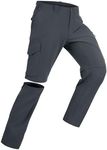Buying Guide for the Best Mens Convertible Hiking Pants
When choosing men's convertible hiking pants, it's important to consider factors that will enhance your comfort and performance during outdoor activities. Convertible hiking pants are versatile, allowing you to switch between pants and shorts depending on the weather and terrain. To find the best fit for your needs, focus on key specifications that affect durability, comfort, and functionality.MaterialThe material of hiking pants is crucial as it determines durability, breathability, and comfort. Common materials include nylon, polyester, and spandex blends. Nylon is known for its durability and resistance to abrasions, making it ideal for rugged terrains. Polyester offers good moisture-wicking properties, keeping you dry during intense activities. Spandex provides stretch, enhancing mobility. Choose a material based on your hiking conditions; for hot climates, prioritize breathability and moisture-wicking, while for rough terrains, durability is key.
FitFit refers to how the pants conform to your body, affecting comfort and mobility. Convertible hiking pants typically come in regular, slim, and relaxed fits. Regular fit offers a balance between comfort and mobility, suitable for most hikers. Slim fit provides a more tailored look and can be beneficial for those who prefer less bulk. Relaxed fit offers more room and is ideal for those who prioritize comfort over style. Consider your personal comfort preference and the type of hiking you plan to do when choosing the fit.
Convertible FeatureThe convertible feature allows pants to be transformed into shorts, providing versatility in changing weather conditions. This feature is important for hikers who experience varying temperatures or want to reduce weight by carrying fewer clothing items. Look for pants with easy-to-use zippers and a comfortable length when converted to shorts. If you hike in areas with fluctuating temperatures, this feature can be particularly beneficial.
PocketsPockets are essential for carrying small items like maps, snacks, or tools. The number, size, and placement of pockets can affect convenience and accessibility. Cargo pockets offer more storage space and are useful for carrying larger items. Zippered pockets provide security for valuables. Consider your storage needs and the type of items you typically carry when choosing pants with the right pocket configuration.
Water ResistanceWater resistance is important for hiking in wet conditions or areas prone to rain. Some pants come with a water-resistant coating that helps repel moisture, keeping you dry. This feature is crucial for maintaining comfort and preventing chafing. If you frequently hike in rainy or damp environments, prioritize pants with good water resistance.
WeightThe weight of hiking pants can affect your overall comfort and energy expenditure during long hikes. Lightweight pants are easier to pack and carry, making them ideal for backpacking trips. Heavier pants may offer more durability and protection but can be cumbersome. Consider the length and intensity of your hikes when deciding on the weight of your pants.















